American Sabbatical 108: 5/10/97
Blue Ridges
5/10.. Virginia.
We’ve got our road rituals perfected now. The morning assemblage and departure. The daily
Owl vetting. Plotting the navigation. Finding roadfood. The tour.
The sketch. The hooting at wrong turns or unclear maps and signs.
The laughter over another day’s absurdities. The quest for lodging.
Waiting for Homer.
Now we are going through the motions with cruise control on. The
Virginia Mountains in Spring are especially beautiful, and they
are like heroic musak for us. When we open out and hear it, we
are moved, but mostly we’re riding the elevator. Going home.
|
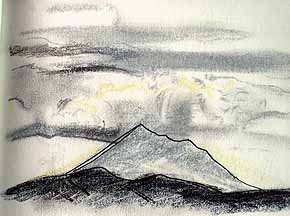
The Ridges
|
We rode the crest of the mountains from Roanoke to Charlottesville,
up on the Blueridge Parkway. Spring is recapitulated top to bottom
out here. On the high ridges, above 3000 feet, the trees are barely
in bud. Hunched, snarly things, mostly oaks and ash at a guess,
judging by the barks and limbs. There appears to be a lot of standing
deadwood up here, but that may be a comparative allusion, because
the limbs are so bare. We have noticed stretches of Pennsylvania
mountainside in late summer where the trees aren’t in leaf, in
recent years, however. Is there a niche die-off in progress?
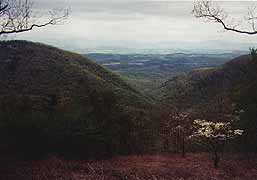
Looking Downslope
|
Downslope the trees get taller, straighter, and proceed from first
leaves to full spread as you descend into the warm moist valleys.
By the time you hit bottom the variety of species is overwhelming.
The great temperate woods of Eastern North America, one of Nature’s
masterworks. I’ve religiously avoided woodyards and such lumbered
temptations this trip. Owl is having trouble with the upgrades
as is. But in another life I’ll roam these hills in a pickup,
with a chainsaw. |
Wildflowers are everywhere, at all altitudes, in all shades. Even
the windswept and chill crests are carpeted in tiny glories. Acres
of pink lady-slippers. Miles of purples and pinks and starred
whites. Violets under every tree. The dogwoods are making their
white and pink and yellow explosions in the higher woods. Laurel
are just opening lower down. Purple-flowered Paulonia are abundant
near the river bottoms.

Peggy's Vista
The vistas are compelling. Western in their sweep, if more humid
and rounded in contour. Heart-liftingly grand. Blue ridges, indeed.
Often seried into the diminishing distance. On the east slopes
of the Appalachians the spring leaves are all in shades of green-bronze.
The hills have a golden sheen, from almost yellow down to a keylime
green. The coloring follows the topography, with the crests outlined
in polished bronze against the valley greens. The Parkway often
skirts a cliff-edge, and you are looking down on the lesser Appalachia
and out to the farthest heights. The sensuous folding and articulation
is balletic, and you can understand Copeland’s inspiration to
the dance.
| Looking down into the fertile valleys west of Charlottesville,
not densely settled to this day, you have to wonder at the forces
driving Boone and the other Westerers. This country lives up to
its name, and the longing to see overhill would have to be fabulously
compelling to drive people beyond this Virginia. |
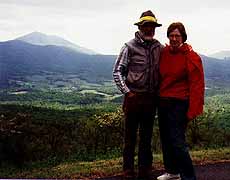
Blue Ridgers
|
On Saturday we came down off the heights to tour Cyrus McCormick’s
farm, west of the Blue Ridge Parkway. The road dropped 2000 feet
in a couple of miles, and was almost as knucklewhite as California
mountain descents. At least the Californians respect your intelligence.
Everywhere else, where the signs say 20 MPH you can do 30 in comfort.
When it says 20 in California, you better. This joyride had us
centrifuging at 25.
(Memo #105)
May 10 Cyrus McCormick
Who? inventor of agricultural machinery, industrialist
What? mechanical reaper
When? 1831
Where? western Virginia
How? his own blacksmith / carpentry training + a tinkerer father
Topics: inventors, agricultural history, farm machinery mechanization
Questions: What inventions affect us the most? What was the impact
of McCormick’s reaper?
|
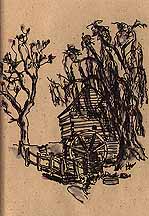
McCormick's Mill
|
I remember heated discussions in school of the world’s greatest
inventions. Fire? The printing press? Penicillin? Cyrus McCormick
is credited by some with creating the greatest invention of the
19th century. His reaper made it possible to cut farm labor drastically
(specifically in harvesting). He began the mechanical revolution
in farm machinery which has reduced the percentage of our population
required to raise food from 90% in 1800 to about 3% today.
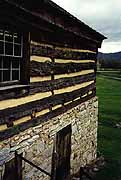
Mac's Place
|
Walnut Grove (the McCormick place at the foot of the Blue Ridge
mountains in west central Virginia) shows the influences behind
the invention. The farm is in rolling farmland, rich wheat growing
territory in the early 1800s. There is a forge and a grist mill.
McCormick’s father Robert made his living as a miller and blacksmith
and was a tinkerer, determined to create inventions to increase
farm efficiency. He had experimented with reapers, but never made
an effective model. Acquiring skill with wood and metal, Cyrus
also focused on improving harvesting methods. |
Cyrus McCormick first invented a lightened scythe (the tool used
for cutting wheat). Then in 1831 he demonstrated the first horse
drawn mechanical reaper. It was made almost entirely of wood.
A wide horizontal blade towed behind a horse cut the wheat which
fell behind the blade on to a low and wide wooden platform. A
raker would walk alongside pulling the cut grain off the platform.
The McCormicks did two public exhibitions with their new reaper.
They showed that two men using the scythe (one driving and one
raking) could harvest six acres in one half day (an amount that
normally required a full day for five men with scythes)!
| McCormick made the first 100 reapers in his blacksmith shop at
Walnut Grove and sold them for $12.50 apiece. He then moved to
Chicago and started the first farm machinery factory. This was
the origin of his company, International Harvester, which became
the world’s largest producer of farm machinery. The McCormick
machines helped open the Great Plains. McCormick kept improving
the reaper (a seat for the raker, then an automatic raker, then
a cord binder - a simplified baler). He made a huge fortune and
accumulated many honors. He instituted new business practices:
machine performance guarantees, easy credit terms for farmers,
slick advertising. |
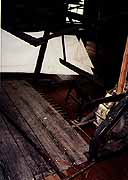
Early Reaper
|
The Walnut Grove site presents the story simply and effectively.
The forge and grist mill are preserved, two simple “cabins” with
two stories each, down the hill from the large brick farmhouse.
The forge is in the basement of one cabin with Cyrus McCormick’s
own tools still in place. The upper floor has a replica of the
first reaper, a large case with 14 scale models of McCormick machines,
and large photos of farmers and McCormick machines at work around
the world. One photo shows farmers in India cutting wheat with
small hand sickles. Another photo shows the first horse drawn
reaper with human raker alongside. Native American and Third World
farmers work with different McCormick reapers today.
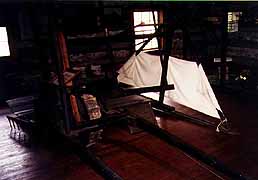
Another view
|
Walnut Groves is still a working farm, now called the Shenandoah
Valley Agricultural Research and extension Center. Faculty and
students work on agricultural improvements here. |
As we drove across the Great Plains we would see lines of colorful
farm machinery in front of dealerships in every town (huge combines
with air conditioned cabs fifteen feet above the ground and gigantic
tires, tractors and a gazillion intricate attachments for breaking
soil, fertilizing, seeding, weeding, reaping, baling, loading,
moving grain). In December in Arkansas we saw huge combines working
at night by powerful headlights. In the spring we see the dust
plumes behind the huge contraptions that break soil in twenty
foot swaths from Louisiana to New York state. All the machines
that revolutionized farming are the offspring of McCormick’s mechanical
reaper.
5/10.. cont.
We hairpinned our way back onto the ridge and enjoyed sunshowers breaking through the
western clouds. Rode the high ground, gawping at the grandeur,
until Charlottesville hove over the horizon, then plunged into
the populous stews.

Bryce's Blue Ridge
Charlottesville is another kettle of fish. We're in the heartland
of Virginia Society here and the noses are eversoslightly elevated.
Manses, big and small, dot the swells, with the Blue Ridges behind.
Peggy wants to see Jefferson’s buildings at the University of
Virginia, so we climb that hill above town, and enter an elite
atmosphere. A wedding was in progress, and the institutional signs
and traffic cops indicate that this is part of UVa’s social function.
The wedding party looked grand, indeed, on the lawn before the
chapel.
There was no near parking for us hoi polloi, however. We cruised
round and about admiring the NO signs, until we found a way into
the inner sanctum of the main quad and parked in some professor’s
perkhole. “Do you suppose Sandy is in?” Peggy said loudly as we
unfolded. A dozen steps up from the Owl and we were within the
hallowed quadrangle.
Tom’s dome-on-a-temple sits at the top of the long sloping lawn,
which is completely enclosed by single-story red-brick residences,
pierced by brick archways, and punctuated by Greek pillar-and-portico
facades every dozen doorways or so. With mature shade trees overshadowing
patches of the quad, this is an idyllic enclave, out of the wind
and weather. It has all the feeling of cloistered condescension
that the BEST colleges strive for, compounded by being a walled
courtyard. A cathedral close for the Temple of Learning. Peggy
reported the same claustrophobia she gets in Harvard Yard. I though
it rather Brit for that old Francophile to have designed.
I know, I know. This is one of our architectural treasures as
a civilization, but what’s the message here? Elite faculty and
students get to have their brass nameplates on their private rooms
opening onto the lawn of exclusivity. The slave quarters are down
the hill. Not a person of color visible anywhere. I take it back.
There was a black sweeping the street at a lower reach of the
University. This is the least integrated part of the South we’ve
seen. Keeping up a noble tradition. OLLIE FOR SENATE, read the
bumperstickers.
The Owl glided down from the height, and lit in a back alley opening
onto a pedestrian mall in the middle of Charlottesville. Eye-easing
old brick shops and restaurants, cafes and bookstores. Noticeably
more integrated than UVa, but the blacks all in service roles.
Maybe a Saturday sample gives a skewed impression. Our veggie
meal was toothsome, and our postprandial stretched a tendon or
two. The sun had finally decided to stay out, and a westerly was
shaking the trees. We found a dosshouse out by the interstate
and played tag with Homer.








